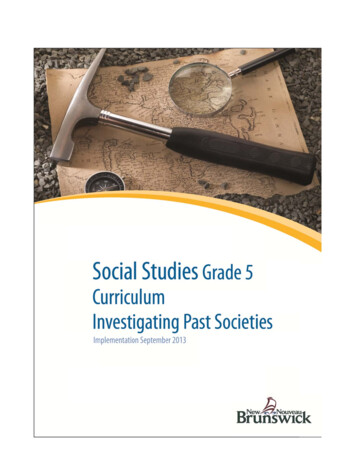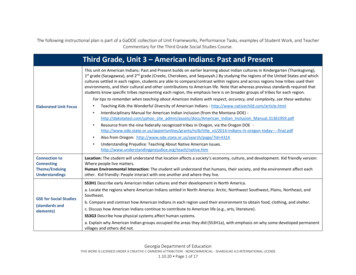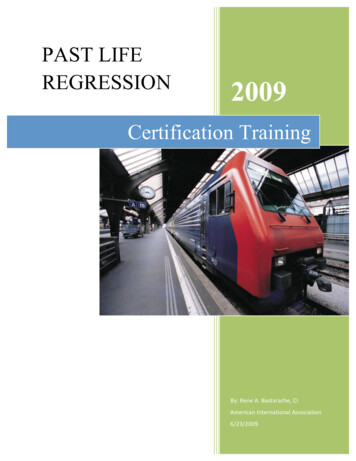
Transcription
AcknowledgmentsThe Departments of Education acknowledge the work of the social studies consultantsand other educators who served on the regional social studies committee.New BrunswickJohn HildebrandBarbara HillmanNova ScotiaMary FedorchukBruce FisherRick McDonaldJennifer BurkeNewfoundland and LabradorDarryl FillierPrince Edward IslandBethany DoironLaura Ann NoyeThe Departments of Education also acknowledge the contribution of all theeducators who served on provincial writing teams and curriculum committees,and who reviewed and/or piloted the curriculum.
Table of ContentsIntroduction . 1Background . 1Aims of Social Studies . 1Purpose of Curriculum Guide . 2Guiding Principles. 2Program Design and Outcomes . 4Overview . 4Essential Graduation Learnings . 5General Curriculum Outcomes . 6Processes . 8Attitudes, Values, and Perspectives . 9Contexts for Learning and Teaching . 12The Learner . 12Equity and Diversity. 15Principles Underlying the Social Studies Curriculum . 15The Social Studies Learning Environment . 16Assessing and Evaluating Student Learning. 28Curriculum Overview. 33Entry-9 Social Studies. . 33Aims of Social Studies. 33Grade 5 Specific Curriculum Outcomes . 34How to Use the Four-Column, Two-Spread Curriculum Layout . 35Grade 5 Curriculum . 38Unit 1: Introduction . 41Unit 2: Environment . 47Unit 3: Social Structure . 52Unit 4: Decision-Making . 58Unit 5: Interactions . 68Unit 6: My Society. 74Appendices . 80Appendix A: Concepts in Entry – 9 Social Studies . 81
Appendix B: Inquiry Approach to Organizing Thinking Concepts and Skills . 82Appendix C: Societies . 85Appendix D: Beothuk Encampments . 86Appendix E: Terminology and Teaching Structures . 88Appendix F: Using Primary Sources in the Classroom. 91Appendix G: Student Response Journals . 94Appendix H: Portfolio Assessment . 96
IntroductionIntroductionBackgroundThe Atlantic Canada social studies curriculum wasplanned and developed by regional committees whosedeliberations were guided by consideration of thelearners and input from teachers. The regionalcommittees consisted of teachers, other educatorsand consultants with a diverse range of experiencesand backgrounds in education. Each curriculum levelwas strongly influenced by current social studiesresearch and developmentally appropriate pedagogy.Aims of Social StudiesThe vision for the Atlantic Canada social studiescurriculum is to enable and encourage students toexamine issues, respond critically and creatively, andmake informed decisions as individuals and as citizensof Canada and of an increasingly interdependentworld.An effective social studies curriculum preparesstudents to achieve all essential graduation learningsand 21st century competencies. In particular, socialstudies, more than any other curriculum area, is vital indeveloping citizenship. Social studies embodies themain principles of democracy, such as freedom,equality, human dignity, justice, rule of law, and civicrights and responsibilities.The social studies curriculum provides opportunitiesfor students to explore multiple approaches that maybe used to analyze and interpret their own world andthe world of others. Social studies presents uniqueand particular ways for students to view theinterrelationships among Earth, its people, and itssystems. The knowledge, skills, and attitudesdeveloped through the social studies curriculumempower students to be informed, responsible citizensof Canada and the world, and to participate in thedemocratic process to improve society.CAMET Social Studies Grade 51
IntroductionIn particular, the social studies curriculum: Purpose ofCurriculum Guideintegrates the concepts, processes, and waysof thinking drawn from the diverse disciplinesof the social sciences (including history,geography, economics, political science,sociology, and anthropology). It also drawsfrom literature and the pure sciences;provides the multidisciplinary lens throughwhich students examine issues affecting theirlives from personal, provincial, national,academic, pluralistic, and global perspectivesThe overall purpose of this curriculum guide is toadvance social studies education and social studiesteaching and learning, and at the same time,recognize and validate effective practices that alreadyexist in many classrooms.More specifically, this curriculum guide: Guiding Principlesprovides detailed curriculum outcomes towhich educators and others can refer whenmaking decisions concerning learning,experiences, instructional techniques, andassessment strategies in the grade 5 socialstudies program;informs both educators and members of thegeneral public about the philosophy and scopeof social studies education for grade 5 in theAtlantic Provinces;promotes the effective learning and teaching ofsocial studies for students enrolled in grade 5classrooms.All kindergarten to grade 9 curriculum andresources should reflect the principles, rationale,philosophy, and content of the Foundation for theAtlantic Canada Social Studies Curriculum (1999)by: 2being meaningful, significant, challenging,active, integrative, and issues based;being consistent with current researchpertaining to how children learn;incorporating multiple perspectives;promoting the achievement of 21st CenturyCompetencies, existing EssentialCAMET Social Studies Grade 5
Introduction CAMET Social Studies Grade 5Graduation Learnings (EGLs), GeneralCurriculum Outcomes (GCOs), and KeyStage Curriculum Outcomes (KSCOs);reflecting a balance of local, national, andglobal content;promoting achievement in the processes ofcommunication, inquiry, and participation;promoting literacy through the socialstudies;developing knowledge, skills, and attitudesfor lifelong learning;promoting the development of informed andactive citizens;contributing to the achievement of equityand supporting diversity;supporting the realization of an effectivelearning environment;promoting opportunities for cross-curricularconnections;promoting resource-based learning;promoting the integration of technology inlearning and teaching social studies;promoting the use of diverse learning andassessment strategies.3
Prograam Design and OutcomesProogramm Dessign anda OOutcommesOveerviewThis social studi es curriculum addresses 21st Centuurympetencies aand is basedd on Foundaation for the AtlanticComCanaada Social SStudies Currriculum (19999). SpecificCurrriculum Outccomes (SCOOs) were devveloped to beeconggruent with KKey-Stage CCurriculum OOutcomes (KKSCOs),General Curricu lum Outcommes (GCOs), and EssenttialGradduation Learrnings (EGLss). In additioon, the proceesses ofsociaal studies, a s well as thee attitudes, vvalues, andperspectives, aree embeddedd in the SCOOs.4CAMET Soocial Studies Grade 5
Program Design and OutcomesEssential GraduationLearningsAesthetic ExpressionThe New Brunswick Department of Education andEarly Childhood Development is currently workingtowards identifying 21st Century Competenciesconsidered essential for graduates. In 1999 theAtlantic Provinces worked together to identify abilitiesand areas of knowledge considered essential forstudents graduating from high school. These arereferred to as Essential Graduation Learnings. Someexamples of Key-Stage Outcomes in social studiesthat help students move towards attainment of theEssential Graduation Learnings are given below.Graduates will be expected to respond with criticalawareness to various forms of the arts and be able toexpress themselves through the arts.By the end of grade 6, students will be expected to: describe how a culture is preserved, modified,and transmittedCitizenshipGraduates will be expected to assess social, cultural,economic, and environmental interdependence in alocal and global context.By the end of grade 6, students will be expected to: identify the distribution of power and privilegein Canadian society and the sources ofauthority of the lives of citizensCommunicationGraduates will be expected to use the listening,viewing, speaking, reading, and writing modes oflanguage(s), as well as mathematical and scientificconcepts and symbols, to think, learn, andcommunicate effectively.By the end of grade 6, students will be expected to: use maps, globes, pictures, models, andtechnologies to represent and describephysical and human systemsPersonal DevelopmentGraduates will be expected to continue to learn and topursue an active, healthy lifestyle.By the end of grade 6, students will be expected to: recognize and explain the interdependentnature of relationships among individuals,societies, and the environmentCAMET Social Studies Grade 55
Program Design and OutcomesProblem SolvingGraduates will be expected to use the strategies andprocesses needed to solve a wide variety of problems,including those requiring language, mathematical, andscientific concepts.By the end of grade 6, students will be expected to: identify and compare events of the past to thepresent in order to make informed, creativedecisions about issues.Technological CompetenceGraduates will be expected to use a variety oftechnologies; demonstrate an understanding oftechnological applications; and apply appropriatetechnologies for solving problems.By the end of grade 6, students will be expected to: identify and describe examples of positive andnegative interactions among people,technology, and the environment.In addition to its specific curriculum outcomes, thiscourse also addresses Key-Stage CurriculumOutcomes within all of the six conceptual strands ofsocial studies, as articulated in the Foundation forAtlantic Canada Social Studies (1999). Similarly, theSocial Studies 5 curriculum provides myriadopportunities for students to engage in the three keysocial studies processes of communication, inquiry,and participation.General CurriculumOutcomesCitizenship, Power, andGovernance6The General Curriculum Outcomes (GCOs) for thesocial studies curriculum are organized around sixconceptual strands. These General CurriculumOutcomes statements identify what students areexpected to know and be able to do upon completionof study in social studies. Specific social studiesconcepts are found within the conceptual strands (seeAppendix A). Examples of Key-Stage Curriculumoutcomes by the end of grade 6 are given for eachGeneral Curriculum Outcome.Students will be expected to demonstrate anunderstanding of the rights and responsibilities ofcitizenship, and the origins, functions, and sources ofpower, authority, and governance.CAMET Social Studies Grade 5
Program Design and OutcomesBy the end of grade 6, students will be expected to: identify and explain the rights andresponsibilities of individual citizens in a local,national, and global context; recognize how and why individuals and groupshave different perspectives on public issues.Culture and DiversityStudents will be expected to demonstrate anunderstanding of culture, diversity, and world view,while recognizing the similarities and differencesreflected in various personal, cultural, racial, andethnic perspectives.By the end of grade 6, students will be expected to: explain why cultures meet human needs andwants in diverse ways; describe how perspectives influence the waysin which experiences are interpreted.Individuals, Societies, andEconomic DecisionsStudents will be expected to demonstrate the ability tomake responsible economic decisions as individualsand as members of society.By the end of grade 6, students will be expected to: give examples of various institutions that makeup economic systems; explain how a government’s policies affect theliving standards of all its citizens.InterdependenceStudents will be expected to demonstrate anunderstanding of the interdependent relationshipsamong individuals, societies, and the environment locally, nationally, and globally - and the implicationsfor a sustainable future.By the end of grade 6, students will be expected to: identify and explain the key characteristics ofsustainable practicesPeople, Place, and EnvironmentCAMET Social Studies Grade 5Students will be expected to demonstrate anunderstanding of the interactions among people,places, and the environment.7
Program Design and OutcomesBy the end of grade 6, students will be expected to: ask geographic questions; acquire, organize,and analyze geographic information; andanswer geographic questions at an ageappropriate level describe examples of cause and effect andchange over time.Time, Continuity, and ChangeStudents will be expected to demonstrate anunderstanding of the past and how it affects thepresent and the future.By the end of grade 6, students will be expected to: identify, evaluate, and use appropriate primaryand secondary sources to learn andcommunicate about the past research and describe historical events andideas from different perspectives.ProcessesThe social studies curriculum consists of three majorprocesses: communication, inquiry, and participation(see Appendix B for a Process-Skills Matrix). Theseprocesses are reflected in the “Suggestions forLearning and Assessment” found in social studiescurriculum guides. These processes incorporate manyskills - some of which are responsibilities sharedacross curriculum areas, whereas others are critical tosocial studies.CommunicationCommunication requires that students listen, read,interpret, translate, and express ideas and information.InquiryInquiry requires that students formulate and clarifyquestions, investigate problems, analyze relevantinformation, and develop rational conclusionssupported by evidence.Participation8Participation requires that students act bothindependently and collaboratively in order to solveproblems, make decisions, and negotiate and enactplans for action in ways that respect and value thecustoms, beliefs, and practices of others.CAMET Social Studies Grade 5
Program Design and OutcomesAttitudes, Values, andPerspectivesBy Conceptual StrandListed below are major attitudes, values, andperspectives in grade 5 social studies that have beenorganized according to the six conceptual strands andthe three processes of the foundation document.Some attitudes, values, and perspectives areembedded in more than one strand or process (this isconsistent with the integrative nature of social studies).Citizenship, Power, and Governance appreciate the varying perspectives on theeffects of power, privilege, and authority onCanadian citizens develop attitudes that balance rights withresponsibilities value decision making that results in positivechangeCulture and Diversity identify examples of informal and formalgroups to which they belong and describe thefunction of those groups appreciate that there are different world views appreciate the different approaches of culturesto meeting needs and wantsIndividuals, Societies, and Economic Decisions give examples of various institutions that makeup economic systems recognize the varying impacts of economicdecisions on individuals and groups recognize the role that economics plays inempowerment and disempowermentInterdependence examine and explain the causes andconsequences of interactions amongindividuals, groups, and societies recognize the varying perspectives on theinterdependence among society, the economy,and the environment identify and explain the key characteristics ofsustainable practicesCAMET Social Studies Grade 59
Program Design and OutcomesPeople, Place, and the Environment appreciate the varying perspectives of regions value maps, globes, and other geographicrepresentations as valuable sources ofinformation and learning appreciate the relationships between attributesof place and cultural valuesTime, Continuity, and Change value society’s heritage appreciate that there are varying perspectiveson a historical issueBy ProcessCommunication read critically respect other points of view use various forms of group and interpersonalcommunicationInquiry recognize that there are various perspectivesin the area of inquiryapply a variety of thinking skills and strategiesappreciate the value of critical and creativethinkingParticipation 10take responsibility for individual and groupworkengage in a variety of learning activitiesrelate to ecosystems in sustainable ways andpromote sustainable practices on a local,regional, national, and global levelCAMET Social Studies Grade 5
Program Design and OutcomesCAMET Social Studies Grade 511
Contexts for Learning and TeachingContexts for Learning and TeachingThe LearnerThe adolescent years between the ages of 10 and 14represent the developmental stage that leads tomaturity or adulthood. Because educators have animportant role in helping young people prepare for theadult world, they need to know and appreciateadolescent characteristics and their application tolearning.During the middle years, the adolescent learnerexperiences rapid and significant change with respectto physical, emotional, social, intellectual, and moraldevelopment. These changes are often intense andvaried and, therefore, need to be acknowledged bythose who direct and foster adolescents’ developmentand learning.While some general characteristics for adolescentshave been identified, it should be recognized thatthese characteristics vary at each grade and age.Each adolescent is a unique individual and anyattempt to classify must be regarded as extremelygeneral. Nonetheless, the following scheme highlightsfor the educator some characteristics of youngadolescents and outlines their implications forlearning.PhysicalAdolescent development is marked by acceleratedand variable growth rates. Strength, energy levels,stamina, and sexual maturity of boys and girls occur atdifferent times and rates. Physical changes alter theway young adolescents perceive themselves, butthese perceptions differ for boys and girls. Theacceleration of growth and related physical changesmake demands on the energies of early adolescents.In learning how to adjust to their “new body,” theyexperience periods of over-activity and listlessness - atendency that overtires them until they learn tomoderate their activity.Early adolescents need experiences and opportunitiesthat help them understand their own physicaldevelopment. School should provide opportunities forconstructive social interaction and establish a healthy,stable classroom environment. To channel theirenergy, young adolescents require a variety ofphysical activities that stress skill improvement andaccommodate differences in size, weight, strength,12CAMET Social Studies Grade 5
Contexts for Learning and Teachingand endurance. Because of the wide ranges inphysical development between boys and girls, what istaught and how it is taught should reflect the range ofneeds and interests of students.SocialYoung adolescents are searching for greaterautonomy as they attempt to define themselvesindependent of the family unit. As they become moresocially interactive, many engage in risk-takingbehaviours, family allegiance diminishes, and peerrelationships take on increased importance.Conformity to the dress, speech, and behaviour oftheir peer group is quite common. They appear tofluctuate between a demand for independence and adesire for guidance and direction. At this time authoritystill remains primarily with the family, but theadolescent will exercise the right to question or rejectsuggestions from adults.Parental involvement in the lives of young adolescentsis crucial and should be encouraged. There is a needfor many positive social interactions with peers andadults. Young adolescents benefit from opportunitiesto work with peers in collaborative and small-grouplearning activities, as much of their learning occurs ina social context. Yet, they require structure and clearlimits as well as opportunities for setting standards forbehaviour and establishing realistic goals. Activitiessuch as role-playing and sociodramas allow them toexplore ways of dealing with various situations thatmay arise.EmotionalYoung adolescents display widely different and oftenconflicting emotions. Their moods, temperaments, andbehaviours are profound and intense. They seem tochange from one moment to the next, they are oftenunpredictable, and their feelings tend to shift betweensuperiority and inferiority. Appraisals of self are oftenoverly critical and negative as they frequently makecomparisons and see themselves deficient in manyways. This age group is extremely sensitive tocriticism of any kind and is easily offended. Feelings ofinadequacy, coupled with fear of rejection by their peergroup, contribute to low self-esteem. Adolescents seetheir problems as unique and they often exaggeratesimple occurrences.To develop emotional confidence, adolescents needopportunities that allow them to release emotionalstress and develop decision-making skills. LearningCAMET Social Studies Grade 513
Contexts for Learning and Teachingactivities should be designed to enhance self-esteem,to recognize student accomplishments, and toencourage the development of positive attitudes.Young adolescents need opportunities to test theirstrengths and weaknesses as they explore issues thatare of concern to them.IntellectualIntellectual development varies tremendously amongearly adolescents. While some are learning to handlemore abstract and hypothetical concepts and to applyproblem-solving approaches to complex issues, amany are still in the stage of concrete operations.Adolescents have a present focus as opposed to afuture orientation. During this stage they retain acertain egocentrism, which leads them to believe thatthey are unique, special, even invulnerable to harm.Adolescents may be unaware of the consequences ofrisk-taking behaviour. As their ability to process andrelate information increases, there is a tendency tosearch for an understanding of rules and conventionsand to question the relevance of what is taught.Young adolescents need opportunities to develop theirformal thinking skills and strategies if they are to movefrom concrete to abstract thinking. To develop theskills of critical analysis and decision making, youngadolescents should be exposed to experientiallearning where they can apply skills to solve real-lifeproblems, and question and analyse significant issues.Aesthetic14Each person has an aesthetic dimension. Adolescentsare exposed to artistic processes and products in avariety of genres and cultures. They are providedopportunities to create, perceive, and communicatethrough the arts. Critical thinking, analytical, andproblem-solving skills are developed and applied inpractical learning experiences. An appreciation for andexperience in those things that constitute the arts addto an understanding of the world, culture, andcommunity. Adolescents with an aesthetic sensibilityvalue culture, environment, and personalsurroundings.CAMET Social Studies Grade 5
Contexts for Learning and TeachingEquity and DiversityThe Atlantic Canada social studies curriculum isdesigned to meet the needs and interests of allstudents. The curriculum should provide for theinclusion of the interests, values, experiences, andlanguage of each student and of the many groupswithin our local, regional, national, and globalcommunities.The society of Atlantic Canada, like all of Canada,reflects a diversity of race, ethnicity, gender, ability,values, lifestyles, and languages. Schools shouldfoster the understanding of such diversity. Socialstudies curricula promote a commitment to equity byvaluing, appreciating, and accepting the diverse andmulticultural nature of our society, as well as byfostering awareness and critical analysis of individualand systemic discrimination.In a school setting characterized by mutual trust,acceptance, and respect, student diversity is bothrecognized and valued. All students are entitled to berespected and valued and, in turn, are responsible forrespecting and valuing all other people. They areentitled to an educational system that affirms theirgender, racial, ethnic, and cultural identity, andpromotes the development of a positive self-image.Educators should ensure that classroom practices andresources positively and accurately reflect diverseperspectives and reject prejudiced attitudes anddiscriminatory behaviours.Principles Underlyingthe Social StudiesCurriculumCAMET Social Studies Grade 5Empowering and effective social studies is meaningful,significant, challenging, active, integrative, and issuesbased. Meaningful social studies encourages studentsto learn through purposeful experiencesdesigned around stimulating ideas, socialissues, and themes, and discourages thememorization of disconnected pieces ofinformation. Significant social studies is student-centredand age appropriate. Superficial coverage oftopics is replaced by emphasis on the trulysignificant events, concepts, and principles thatstudents need to know and be able to apply intheir lives. Challenging social studies involves teachersmodelling high expectations for their students15
Contexts for Learning and Teaching The Social StudiesLearning EnvironmentThe Effective Social StudiesClassroomand themselves, promoting a thoughtfulapproach to inquiry, and demanding wellreasoned arguments.Active social studies encourages students toassume increasing responsibility for managingtheir own learning. Exploration, investigation,critical and creative thinking, problem solving,discussion and debate, decision making, andreflection are essential elements of thisprinciple. This active process of constructingmeaning encourages lifelong learning.Integrative social studies crosses disciplinaryborders to explore issues and events, whileusing and reinforcing informational,technological, and application skill
CAMET Social Studies Grade 5 7 Culture and Diversity Individuals, Societies, and Economic Decisions Interdependence People, Place, and Environment By the end of grade 6, students will be expected to: identify and explain the right










